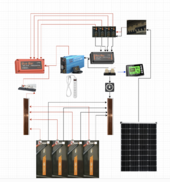I am kinda sitting back just watching your guys discussion unfold,I know what most people say (2 lugs max on a terminal) but I was always curious as to why, my own brain agrees with hedges and tells me there would be less resistance all joined together as opposed to traveling through a bussbar(more conductor) I see sense in robs example explaining different sized/material lugs how that could cause Hotspots, but let's say there are 4 identical lugs stacked on one nut and bolt, no buss. That would make only 3 contact points that's carrying current. If you take them 4 same lugs and put them on a bussbar instead, stacked 2 lugs on 2 bolts, that would then create 4 contact points that's carrying current through more conductor (buss metal)
Another point on most bus bars is the length of the bolt used. If it is a bolt sticking up and it is long you can run the nut down on it. If it a short bolt you will run out of space quickly.
The other tidbit on stacking is if you put all the lug on one bolt, say you have 6 lugs - the current from the top one has to travel through the inner ones to reach the bottom.... so you stack with most current. What if you short something and have high up and it has travel through smaller ones... do they melt because they are thin? Does it weld them together?
While looking up stuff for stacking lugs and connections to busbars - it talks about the bus bar rating being 120% of the total number of amps possible from all sources.
In your case to the NEC you have:
4 batteries capable of 200 amps = 800amps
4 CC capable of 40amps = 160amps
(800 + 160 ) * 120% = 1152amps == so you use your junk yard bars (measure those so we can see the ungodly amount of current they are good for)
The bars are the end of the class T and shunt need to cover 160amp * 120% = 192 amps - use either another set of junk yard bars or buy a set of the LiTime or similar bars.
This covers the event where you drop both inverter cables and they short together and it is sunny. The bus bars don't melt, you get a huge flash, spark/smoke ball and the class T blows and all your cheap breaker melt.
Before you ask, you can't depend of fuses to cut power right away so you need to plan for the full capacity of the batteries before something cuts out.
Post pictures of your cheap breakers and pictures of any labels on them. I'd like to look them up and see if they are melty types.
You can push a lot of amps... this is the issue with 12v ... many times more amps that 24 or 48v








